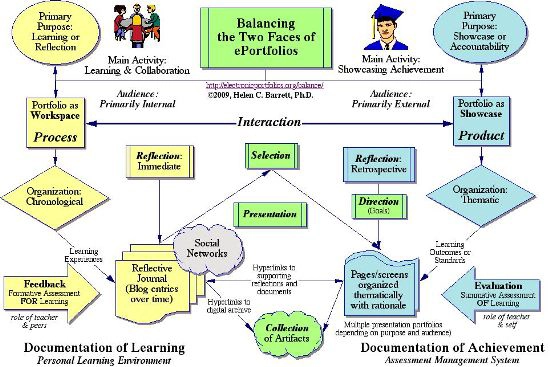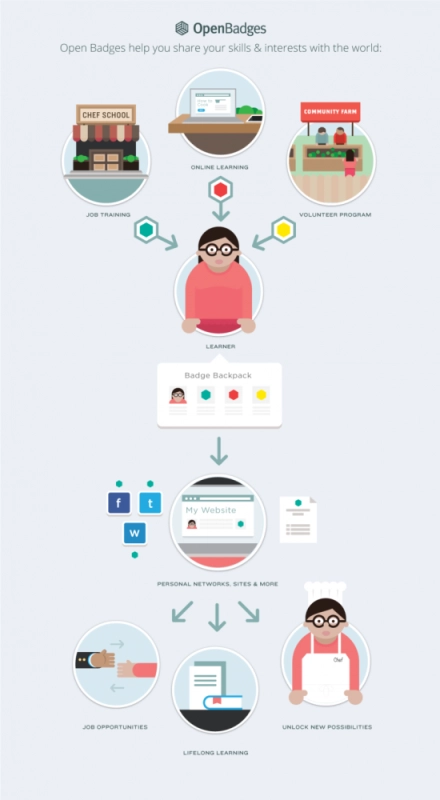Get ready for 2026 and save up to 40% with our volume discounts
Last Updated: 2nd May 2025
E-Portfolios and Open Badges
In this blog we look at the growing influence of Open Badges in online training.
Article
)
The Virtual College team keep a close eye on the latest trends in e-learning, so we can advise our clients on any interesting developments. One trend we have been examining recently is ‘Open Badges’.
We have noted a growing interest in Open Badges and thought it would be useful to offer a simple comparison between e-portfolios and Open Badges and take a look at how they will interact.
What is an e-portfolio? It is an electronic collection of evidence of learning gathered over time and reflecting your learner journey.
This quotation in a report published by JISC in 2008 defines an e-portfolio as:
“…The central and common point for the student experience. It is a reflection of the student as a person undergoing continuous personal development, not just a store of evidence.”
In other words, an e-portfolio reflects the learner journey but also defines the person who has taken that journey. An e-portfolio can consist of an array of digital assets: written text, assignments, reports and such like, photos, videos, observations by others (such as mentors), and items that record reflective thinking.
In 2009, Helen C Barrett produced the diagram below. It positions e-portfolios as a ‘workspace’ where content is logged to demonstrate and share learning with peers and tutors, when the e-portfolio is being used for current activities; or as a ‘showcase’ so it can demonstrate achievement. It is a record that can stay with the learner as the learner’s journey continues, becoming a record of lifelong learning.
 Image originally available at http://www.electronicportfolios.org/balance/
Image originally available at http://www.electronicportfolios.org/balance/
What are open badges? Open Badges are a recent development, first appearing about 12 months ago, and are being pioneered and promoted as an open standard by the Mozilla Foundation (Mozilla are well known for creating the Internet Browser Firefox, so they certainly know their way around the online world).
Mozilla see Open Badges as part of their mission to “keep the power of the Web in people’s hands”:
“Learning today happens everywhere, not just in the classroom. But it's often difficult to get recognition for skills and achievements that happen outside of school. Mozilla's Open Badges project is working to solve that problem, making it easy for anyone to issue, earn and display badges across the web through a shared technical infrastructure. The result: helping people of all ages gain and display 21st century skills and unlock new career and educational opportunities.”
This definition comes from their Wiki, as does this helpful diagram below:
 /n/nImage originally available at https://wiki.mozilla.org/Badges
/n/nImage originally available at https://wiki.mozilla.org/Badges
However, the most informative definition we found for Open Badges lay deep in the Mozilla paper “Open Badges for Lifelong Learning”, with the intriguing subtitle “Exploring an open badge ecosystem to support skill development and lifelong learning for real results such as jobs and advancement”.
This paper is mostly a narrative of how Open Badges will help learners, but deep in the paper we found the clearest message of what the badges aim to do, and how they will integrate with assessment technologies and e-portfolios:
“The badge itself is more than a static image or button, but instead much of the value of thebadge comes from the metadata attached to it. Badges are conversation starters, and theinformation linked to or 'behind' each badge serves as justification and even validation of the badge.
For example, a badge should include information about how it was earned, who issued it and the date of issue. Most importantly, the badge should be hyperlinked back to something demonstrating the criteria for the badge and/or the evidence such as an artifact (sic), document or testimonial. The information 'behind' the badge may differ based on the skill, assessment and issuer, but the concept of a badge as the gateway to further information remains the same.”
So what can we conclude?
The emergence of Open Badges is likely to have a profound effect on e-portfolios. The digital badge fronts a portal to information to be found about the badge’s owner.
Badges are designed to indicate specific information about the skills and knowledge of that person and are often awarded at certain milestone points to reflect their ability and competence in applying what they know.
It is an interesting time for e-portfolios, as they appear to be sitting at the crossroads of technology; we could possibly see e-portfolios emerging as something slightly different in the future, with strong links to badges.
People want to stamp their individuality onto their online presence, one that will stay with them for life, long after they leave fulltime education and work through their career, and badges certainly allow for that.
It is our “forward thinkers” at Virtual College that are watching and innovating in this space at present. We are keeping one step ahead of technology by listening to learners and tracking emerging technologies to ensure our offer is leading edge, and ensuring our customers make informed choices, whether it is a badge or an e-portfolio solution.
By Rod Knox,
Virtual College CEO.
